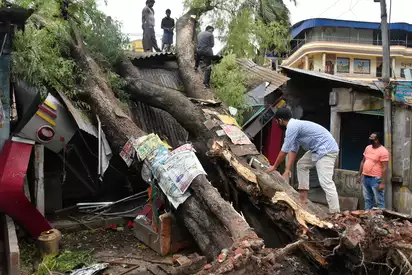The Growing Menace of Cyclones, A Dire Call to Action on Climate Change Or Face More Destruction Putting A Strain On Resources. Can The Govt Keep Up?
Even As cyclone Biparjoy made landfall in Gujarat and is now moving towards Rajasthan & Pakistan, it has in its wake and aftermath left houses and hospitals submerged, people standard, and several injured. The fact is that the frequency of cyclones hitting India has increased in the last few years. It is expected that not only the frequency but also the intensity of cyclones will increase in the coming years.

In recent years, the world has witnessed an alarming increase in the intensity and devastation caused by tropical cyclones. From the coasts of India to the shores of the United States, these destructive storms have left a trail of destruction, loss of life, and economic ruin in their wake.
As we grapple with this escalating crisis, one thing is abundantly clear; we are running out of time. The urgency to address climate change and its impact on cyclones has never been greater. It is a call to action that demands immediate attention from every corner of the globe.

Cyclones Are Intensifying
To substantiate how the number of cyclones has increased in the last few years, a total number of 16 hurricanes have hit India from 2019 to 2023; this includes the latest – Cyclone Biparjoy.
Also to be noted is that the wind speed has also intensified, hence pointing to the unmistakable signs.
Scientific evidence has mounted, revealing the disturbing connection between climate change and the intensification of tropical cyclones. Researchers have unearthed a troubling trend: a rise in the proportion of powerful storms capable of inflicting catastrophic damage.
The Impact Of Cyclones
The destructive power of these cyclones has increased globally, wreaking havoc on vulnerable communities and the growing intensity and the number has left millions of people around the globe left grappling with the aftermath and governments spending much more in restoring infrastructure and taking urgent action to mitigate the disastrous consequences of these menacing storms.
A comprehensive review of existing research published on March 26 in ScienceBrief Review indicates that many regions prone to tropical cyclones can anticipate storm systems of heightened intensity in the coming century. Additionally, the rise in sea levels is expected to exacerbate the risk of coastal flooding caused by tropical cyclones and other events, regardless of any alterations in the cyclones themselves. Future projections from models also suggest an increase in precipitation rates associated with tropical cyclones, which could further amplify the potential for flooding.

Human Influence Amplifying the Storms
The studies showed growing evidence that climate change is probably fueling more powerful hurricanes and typhoons, a trend that is expected to continue as global temperatures rise, amounting to a roughly 5% increase in maximum wind speeds if the globe warms by 2 degrees Celsius.
While natural variability plays a role, the influence of human activity on the intensification of cyclones cannot be ignored. The burning of fossil fuels and the release of greenhouse gases into the atmosphere have set in motion a cascade of events leading to warmer oceans and a more volatile climate. As global temperatures continue to rise, cyclones gather strength, their winds growing more ferocious, and their destructive potential multiplying.
The Race Against Time
It is perhaps inevitable that we find ourselves standing at a critical juncture in human history. With every passing year, the threat of increasingly powerful cyclones looms larger, putting millions of lives at risk and devastating entire regions. The clock is ticking, and the time for action is now waiting for the storm to subside is not an option anymore.
Putting A Strain On Resources, Can The Govt Keep Up
The burden of cyclones falls disproportionately on the most vulnerable communities around the world, and it is imperative to provide support, resources, and aid to those affected; for now, the respective governments are helping, but for how long?
The Only Solution
To combat the intensifying threat of cyclones, concerted efforts must be made on multiple fronts. Governments, organizations, and individuals must prioritize the reduction of greenhouse gas emissions, transitioning to cleaner energy sources, and adopting sustainable practices.
Investments in resilient infrastructure, early warning systems, and disaster preparedness are paramount. Moreover, we must amplify international cooperation and commit to a unified response to this global crisis of climate change, or it may be catastrophic for humanity.
The Last Bit; The intensification of cyclones is a stark reminder of the urgent need to address climate change. We cannot afford to turn a blind eye to the mounting evidence or postpone the necessary action.
The time for half-hearted measures has passed. We must act boldly, decisively, and collectively to curb our carbon emissions, protect vulnerable communities, and safeguard our planet’s future.
The cyclone’s destructive winds know no borders, and neither should our determination to combat climate change. The storm is here, and it’s time to respond with unwavering resolve.






